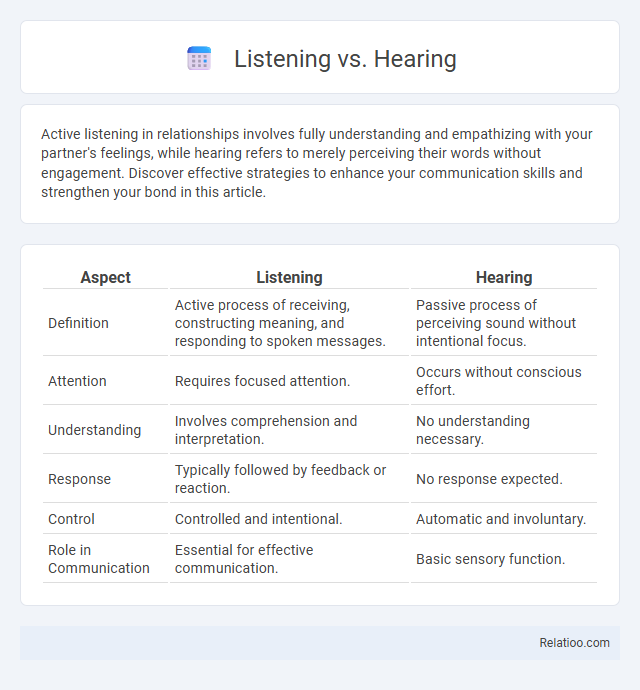Active listening in relationships involves fully understanding and empathizing with your partner's feelings, while hearing refers to merely perceiving their words without engagement. Discover effective strategies to enhance your communication skills and strengthen your bond in this article.
Table of Comparison
| Aspect | Listening | Hearing |
|---|---|---|
| Definition | Active process of receiving, constructing meaning, and responding to spoken messages. | Passive process of perceiving sound without intentional focus. |
| Attention | Requires focused attention. | Occurs without conscious effort. |
| Understanding | Involves comprehension and interpretation. | No understanding necessary. |
| Response | Typically followed by feedback or reaction. | No response expected. |
| Control | Controlled and intentional. | Automatic and involuntary. |
| Role in Communication | Essential for effective communication. | Basic sensory function. |
Understanding the Difference: Listening vs Hearing
Hearing is the passive process of perceiving sound through your ears, while listening involves actively focusing and interpreting those sounds to comprehend meaning. Misunderstanding often arises when you hear words but fail to listen attentively, leading to gaps in communication. Mastering the difference between hearing and listening enhances your ability to connect and respond effectively.
The Science Behind Hearing
Hearing is the passive process by which your ears detect sound waves and transmit signals to the brain, whereas listening requires active cognitive processing to interpret those sounds meaningfully. The science behind hearing involves the cochlea converting mechanical vibrations into electrical impulses that the auditory cortex decodes. Misunderstanding often arises when the brain misinterprets or fails to properly process these signals, highlighting the crucial difference between mere hearing and effective listening.
What Does It Mean to Truly Listen?
Truly listening involves actively engaging with the speaker's message, interpreting both verbal and nonverbal cues to fully comprehend the intent and emotions behind the words. Hearing is merely the passive reception of sound without processing its meaning, leading to superficial understanding. Misunderstanding occurs when the listener fails to grasp the true context or nuances, often due to distractions, assumptions, or lack of attention, highlighting the critical difference between hearing and genuinely listening.
The Role of Attention in Listening
Attention plays a crucial role in transforming hearing into effective listening by allowing you to focus selectively on sounds and messages, filtering out distractions that lead to misunderstanding. Active listening requires cognitive engagement and mental effort to interpret and internalize the content accurately, which reduces errors in communication. Lack of attention often results in missed details and misinterpretations, highlighting the essential function of focused attention in achieving clear understanding.
Barriers to Effective Listening
Barriers to effective listening often include environmental noise, preconceptions, and emotional distractions that interfere with your ability to process and understand the message accurately. Hearing is the passive act of perceiving sound, while listening requires active engagement and cognitive effort to interpret meaning. Misunderstanding occurs when these barriers prevent clear comprehension, leading to communication breakdowns and errors.
How Listening Enhances Communication
Listening enhances communication by actively engaging with the speaker's message, allowing you to fully comprehend and respond accurately. Unlike hearing, which is passive and involves merely perceiving sounds, active listening requires concentration and interpretation of verbal and nonverbal cues. This process minimizes misunderstanding by clarifying intentions and emotions, fostering clearer and more effective interactions.
Common Misconceptions About Hearing and Listening
Hearing is the passive process of perceiving sound, while listening requires active attention and cognitive engagement to interpret and understand the information. A common misconception is that hearing automatically involves comprehension, which often leads to misunderstanding when the listener does not fully process or clarify the message. Your effectiveness in communication improves significantly when you distinguish listening as an intentional act rather than merely hearing sounds.
Strategies to Improve Active Listening
Active listening requires consciously focusing on the speaker's words, tone, and body language to fully comprehend the message, unlike passive hearing which is merely perceiving sound. Misunderstanding often occurs when attention lapses or assumptions distort the intended meaning, making clarifying questions and summarization vital strategies. Techniques such as minimizing distractions, practicing empathy, and providing feedback enhance retention and ensure accurate interpretation in communication.
Listening Skills in Personal and Professional Relationships
Effective listening skills are crucial in personal and professional relationships, as listening involves actively processing and understanding the speaker's message, unlike hearing, which is passive sound perception. Misunderstanding often arises from poor listening habits such as distractions or preconceived notions, leading to communication breakdowns and conflicts. Developing attentive listening skills enhances empathy, trust, and collaboration, fostering stronger connections and productive interactions.
The Impact of Listening on Emotional Intelligence
Listening involves active engagement and comprehension, which significantly enhances emotional intelligence by fostering empathy and better interpersonal connections. Hearing is the passive act of perceiving sound, often lacking the cognitive processing needed for emotional awareness. Misunderstanding occurs when listening fails or is incomplete, leading to misinterpretations that hinder emotional regulation and social effectiveness.

Infographic: Listening vs Hearing
 relatioo.com
relatioo.com